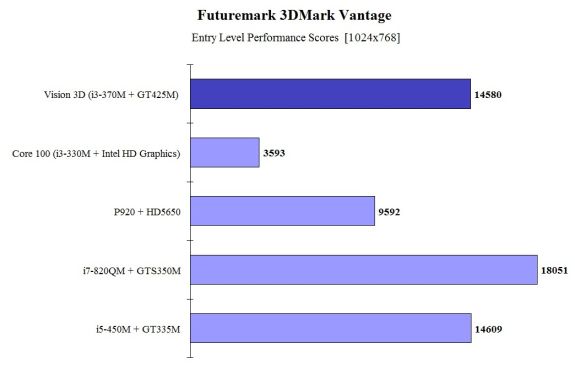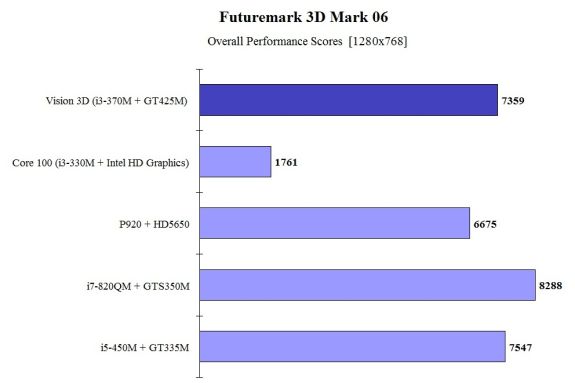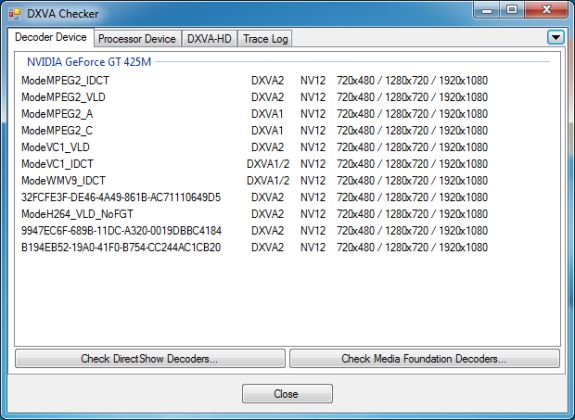ASRock's High-End Vision 3D HTPC Reviewed
by Ganesh T S on October 3, 2010 10:20 AM ESTThe GF108 Fermi lineup was announced by nVidia at the 2010 IFA in the first week of September. We already covered their announcement in a previous piece along with the details of the architecture. I happen to be the first editor at AnandTech to get hold of the actual silicon in a system, and the full responsibility of putting it through the paces fell on me. Though I happen to be more of a HTPC person, I did manage to run a few of the gaming benchmarks developed by Jarred. I have been playing around with various beta driver releases from nVidia ever since I got hold of the engineering sample, but the results presented in this piece are all obtained with MXM driver version 260.66. Before we get to the gaming performance, let us take a look at some of the synthetic benchmarks related to the GPU in the Vision 3D.
The GeForce 425M comes out with surprisingly better performance than the Mobility Radeon 5650. Though the effective memory bandwidth in the 425M (25.6 GBps) is lesser than that available in the 335M (34.1 GBps), the architectural improvements seem to have delivered very similar scores in our two synthetic benchmarks. But, do these improvements show benefits in actual gaming performance? We will see that in the next section.
Our coverage of the 400M series indicated that the number of shaders in almost all the members of the GF108 series is constant at 96. They all have a DDR3 memory interface running at 800 MHz. The processor clock is locked at 2x the graphics clock for all the models. While the default 425M graphics clock frequency is 560 MHz, we could easily overclock it to 650 MHz (435M default frequency) using the nTune program available as part of the nVidia system tools suite. The GPU is very overclocking friendly, and we were even able to ramp up the memory clocks to the rumoured GT 430 specifications without encountering any issues.
The GF108 brings the latest and greatest in PureVideo to the consumer. Based on VP4, it supports hardware accelerated decode of almost all video codecs except Real Media and the On2 codecs. We have already seen the DXVA status of a VP4 enabled device in the GeForce G210 in a previous article. The DXVA Checker report for the 425M is provided below, and there is nothing unexpected in it.













51 Comments
View All Comments
ganeshts - Monday, October 4, 2010 - link
Momentus XT is a hybrid and not a pure hard drive. In any case, I have already linked to a StorageReview.com comparison of the 500 GB WD Scorpio Black and the Momentus XT. There are benchmarks in which the Scorpio Black turns out better.http://www.storagereview.com/western_digital_scorp...
troystarr - Monday, October 4, 2010 - link
I'm curious how fast it can load blu-ray discs, such as the time from blu-ray disc insertion to the BD-Java main menu, speed of interacting with BD-Java menus, etc. I have a Blu-ray Profile 2.0 player that's about 2 years old now, and while it plays blu-ray discs great, it's pretty slow to load them and navigate their menus. If I try to use any Internet-based content via BD Live, it's downright painful. I would love to see comparisons in load time between this device, a typical consumer Blu-ray player, and a Sony PS3.Thanks for the review!
michael.gulde - Monday, October 4, 2010 - link
Was there a cable card for cable tv hd encrypted channels?ganeshts - Monday, October 4, 2010 - link
The ASRock Vision 3D is high end from the viewpoint of supporting the latest standards such as 3D which are yet to go mainstream.Also, the system has been designed taking the world market into consideration, and people outside the US just don't use CableCard.
You can always use the upcoming SiliconDust HD Tuners with CableCard functionality if this is something essential :)
cknobman - Monday, October 4, 2010 - link
this is just too expensive to justify for most consumers.I dont do alot of actual computing from my media room so therefore when I think HTPC I want something that can access my network and stream content and play games.
Those things can be done by already existing equipment in my house or even other new equipment for much cheaper.
PS3 - $299
Xbox 360 - $299
Blu Ray player - > $200
Media Streamer - $50 - $150
True this impressive little unit is also a full blown computer but as someone with 4 other pc's in the house already I dont really need a full blown computer as part of my media room.
I think this would be perfect for someone who dosnt really own a gaming system and/or blue ray player already and would like an all-in-one solution.
Otherwise I think that is really is priced too high to be of any real value to most consumers.
vlado08 - Monday, October 4, 2010 - link
Hi Ganesh, thanks for the good article. I have several questions.1 What was the HDD tems when the GPU was under load? Because the HDD is sitting above the GPU I have some concerns.
2 What does the DPC Latency Checker shows? Are there any latency problems? In the sreen shot of the MPC-HT there are some spikes in the green line?
3 Do we need to disable Intel speed step for latensy free playback?
4 Is it possible to put a HDD vertically mounted to the side wall of the Vision 3D? This way you can have 3 HDD inside - two on the side and one under the DVD/Blu-ray.
ganeshts - Monday, October 4, 2010 - link
1. I never received warnings about HDD temperature when running Furmark. The only time there was a warning was when I was copying around 100 GB of data from the USB 3 port (so much higher write rate than even through GbE network) into internal hard disk, at which point the temperature reached 52 C towards the very end. As long as you are doing normal HTPC activities, I don't think this will be an issue.2/3. I did DPC latency checks for the Core 100, but found no issues with playback even though the checker reported issues. I have come to the conclusion (with help of other editors here at AnandTech), that there is no necessity that there is an issue even if the checker reports it. In all, even though I saw the spikes in MPC-HC, I didn't notice any issues in the playback of Blu-Rays or any of our other test streams, even with SpeedStep enabled.
4. No, there is no space for any more components within the Vision 3D chassis :(
vlado08 - Monday, October 4, 2010 - link
Thanks again for the quick reply and for your enthusiasm.junkles - Monday, October 4, 2010 - link
Hi, Ganesh.So which HTPC functions have you found to be lacking with a Linux distribution such as Ubuntu?
Thanks
ganeshts - Monday, October 4, 2010 - link
For starters, Blu-Ray disc playback and HD audio bitstreaming (even for stand alone files)I just wish we had a Linux program capable of playing back Blu-Rays (particularly considering the fact that all standalone BR players run some version of Linux at the core).